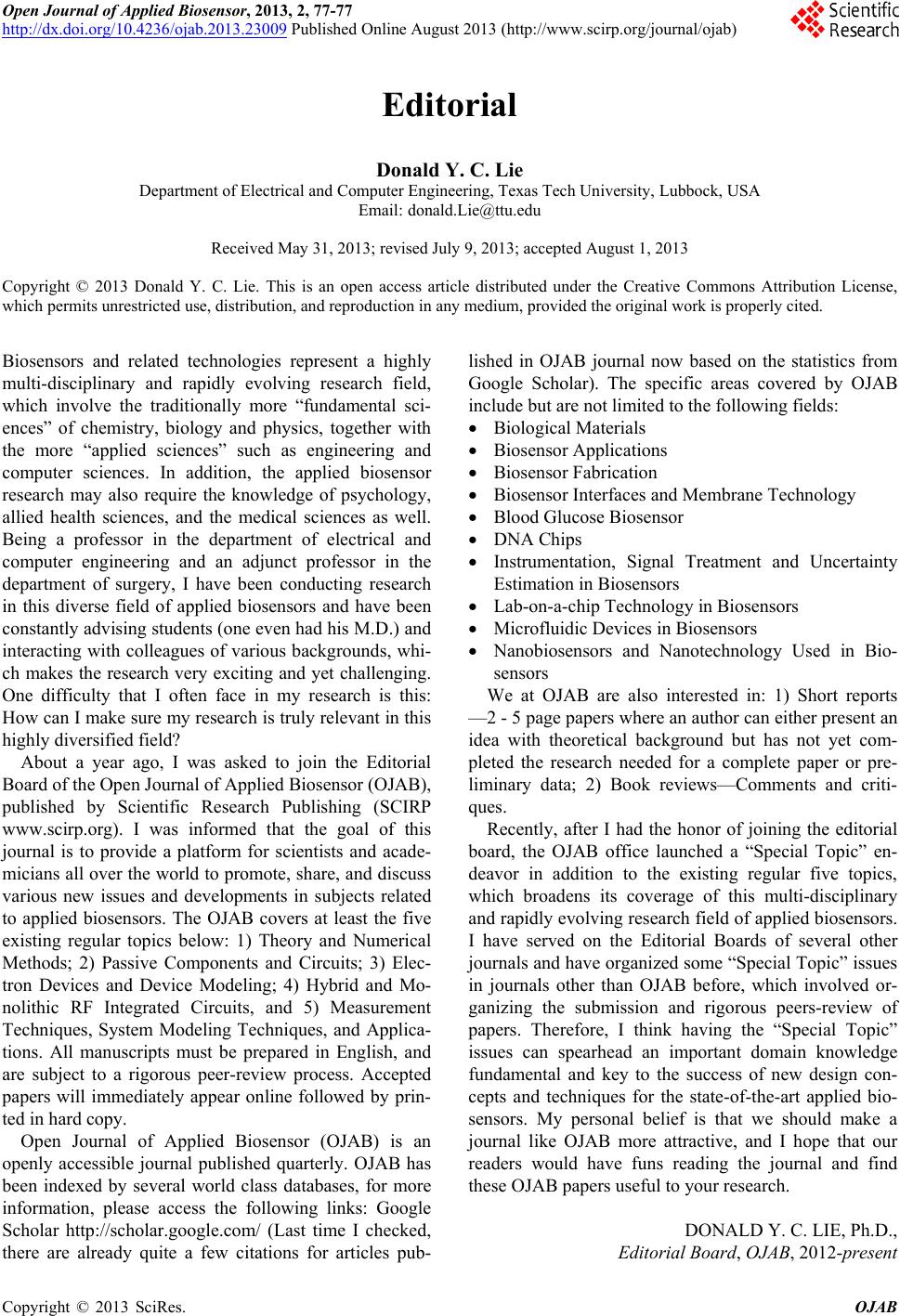Paper Menu >>
Journal Menu >>
 Open Journal of Applied Biosensor, 2013, 2, 77-77 http://dx.doi.org/10.4236/ojab.2013.23009 Published Online August 2013 (http://www.scirp.org/journal/ojab) Editorial Donald Y. C. Lie Department of Electrical and Computer Engineering, Texas Tech University, Lubbock, USA Email: donald.Lie@ttu.edu Received May 31, 2013; revised July 9, 2013; accepted August 1, 2013 Copyright © 2013 Donald Y. C. Lie. This is an open access article distributed under the Creative Commons Attribution License, which permits unrestricted use, distribution, and reproduction in any medium, provided the original work is properly cited. Biosensors and related technologies represent a highly multi-disciplinary and rapidly evolving research field, which involve the traditionally more “fundamental sci- ences” of chemistry, biology and physics, together with the more “applied sciences” such as engineering and computer sciences. In addition, the applied biosensor research may also require the knowledge of psychology, allied health sciences, and the medical sciences as well. Being a professor in the department of electrical and computer engineering and an adjunct professor in the department of surgery, I have been conducting research in this diverse field of applied biosensors and have been constantly advising students (one even had his M.D.) and interacting with colleagues of various backgrounds, whi- ch makes the research very exciting and yet challenging. One difficulty that I often face in my research is this: How can I make sure my research is truly relevant in this highly diversified field? About a year ago, I was asked to join the Editorial Board of the Open Journal of Applied Biosensor (OJAB), published by Scientific Research Publishing (SCIRP www.scirp.org). I was informed that the goal of this journal is to provide a platform for scientists and acade- micians all over the world to promote, share, and discuss various new issues and developments in subjects related to applied biosensors. The OJAB covers at least the five existing regular topics below: 1) Theory and Numerical Methods; 2) Passive Components and Circuits; 3) Elec- tron Devices and Device Modeling; 4) Hybrid and Mo- nolithic RF Integrated Circuits, and 5) Measurement Techniques, System Modeling Techniques, and Applica- tions. All manuscripts must be prepared in English, and are subject to a rigorous peer-review process. Accepted papers will immediately appear online followed by prin- ted in hard copy. Open Journal of Applied Biosensor (OJAB) is an openly accessible journal published quarterly. OJAB has been indexed by several world class databases, for more information, please access the following links: Google Scholar http://scholar.google.com/ (Last time I checked, there are already quite a few citations for articles pub- lished in OJAB journal now based on the statistics from Google Scholar). The specific areas covered by OJAB include but are not limited to the following fields: Biological Materials Biosensor Applications Biosensor Fabrication Biosensor Interfaces and Membrane Technology Blood Glucose Biosensor DNA Chips Instrumentation, Signal Treatment and Uncertainty Estimation in Biosenso rs Lab-on-a-chip Technol ogy in Biosens or s Microfluidic Devices in Biosensors Nanobiosensors and Nanotechnology Used in Bio- sensors We at OJAB are also interested in: 1) Short reports —2 - 5 page papers where an author can either present an idea with theoretical background but has not yet com- pleted the research needed for a complete paper or pre- liminary data; 2) Book reviews—Comments and criti- ques. Recently, after I had the honor of joining the editorial board, the OJAB office launched a “Special Topic” en- deavor in addition to the existing regular five topics, which broadens its coverage of this multi-disciplinary and rapidly evolving research field of applied biosensors. I have served on the Editorial Boards of several other journals and have organized some “Special Topic” issues in journals other than OJAB before, which involved or- ganizing the submission and rigorous peers-review of papers. Therefore, I think having the “Special Topic” issues can spearhead an important domain knowledge fundamental and key to the success of new design con- cepts and techniques for the state-of-the-art applied bio- sensors. My personal belief is that we should make a journal like OJAB more attractive, and I hope that our readers would have funs reading the journal and find these OJAB papers useful to your research. DONALD Y. C. LIE, Ph.D., Editorial Board, OJAB, 2012-present C opyright © 2013 SciRes. OJAB |

